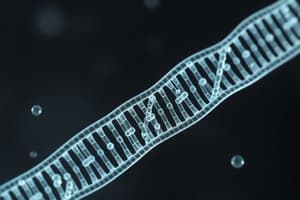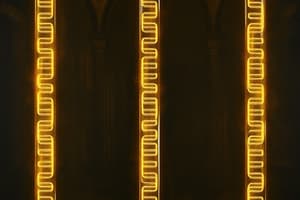Podcast
Questions and Answers
What is the main function of photoreactivation in DNA repair?
What is the main function of photoreactivation in DNA repair?
- Directly repairs UV induced damage (correct)
- Corrects mismatched base pairs
- Replaces missing nucleotide sequences
- Removes damaged DNA segments
Which mechanism of horizontal gene transfer involves direct cell contact?
Which mechanism of horizontal gene transfer involves direct cell contact?
- Transduction
- Replication
- Transformation
- Conjugation (correct)
How do Hfr cells differ from F+ cells?
How do Hfr cells differ from F+ cells?
- Hfr cells have the F plasmid integrated into their chromosomes (correct)
- Hfr cells can only receive plasmids
- F+ cells contain chromosomal DNA
- F+ cells are integrated into the chromosome
What is the role of the operator in an operon?
What is the role of the operator in an operon?
What distinguishes specialized transduction from generalized transduction?
What distinguishes specialized transduction from generalized transduction?
What are restriction endonucleases primarily used for in genetics?
What are restriction endonucleases primarily used for in genetics?
Which of the following methods increases the competency of cells for transformation?
Which of the following methods increases the competency of cells for transformation?
In blue-white screening, what does a white colony indicate?
In blue-white screening, what does a white colony indicate?
What is the primary purpose of nucleotide excision repair?
What is the primary purpose of nucleotide excision repair?
What is defined as the process of transferring genes from parent to offspring?
What is defined as the process of transferring genes from parent to offspring?
What is generation time in microbial growth?
What is generation time in microbial growth?
During which phase of the bacterial growth curve do the symptoms of disease typically develop?
During which phase of the bacterial growth curve do the symptoms of disease typically develop?
Which methods are commonly used to count the number of bacteria in a culture tube?
Which methods are commonly used to count the number of bacteria in a culture tube?
Which classification of oxygen requirement includes organisms that cannot survive in the presence of oxygen?
Which classification of oxygen requirement includes organisms that cannot survive in the presence of oxygen?
What does the streak plate method primarily aim to achieve?
What does the streak plate method primarily aim to achieve?
What does being VBNC indicate about an organism?
What does being VBNC indicate about an organism?
Which group of bacteria is capable of undergoing fermentation?
Which group of bacteria is capable of undergoing fermentation?
What does the catalase test determine about an organism's physiology?
What does the catalase test determine about an organism's physiology?
Which of the following environmental conditions best supports the growth of psychrophiles?
Which of the following environmental conditions best supports the growth of psychrophiles?
What is the optimal growth condition for mesophiles?
What is the optimal growth condition for mesophiles?
Which bacteria group primarily thrives at human body temperature and can be most pathogenic?
Which bacteria group primarily thrives at human body temperature and can be most pathogenic?
What mechanism allows Helicobacter pylori to survive in the acidic environment of the stomach?
What mechanism allows Helicobacter pylori to survive in the acidic environment of the stomach?
What type of medium supports the growth of fastidious organisms by providing extra nutrients?
What type of medium supports the growth of fastidious organisms by providing extra nutrients?
Which experiment demonstrated the transformation principle where non-virulent bacteria became virulent?
Which experiment demonstrated the transformation principle where non-virulent bacteria became virulent?
How do eukaryotic transcription and prokaryotic transcription differ fundamentally?
How do eukaryotic transcription and prokaryotic transcription differ fundamentally?
What is the role of the Shine-Dalgarno sequence in prokaryotic mRNA?
What is the role of the Shine-Dalgarno sequence in prokaryotic mRNA?
What is one of the key findings of Oswald Avery and his colleagues regarding genetic material?
What is one of the key findings of Oswald Avery and his colleagues regarding genetic material?
What fundamental structure did Watson and Crick discover about DNA?
What fundamental structure did Watson and Crick discover about DNA?
Which type of mutation results in the premature termination of protein synthesis?
Which type of mutation results in the premature termination of protein synthesis?
How does polycistronic mRNA differ from monocistronic mRNA in bacterial cells?
How does polycistronic mRNA differ from monocistronic mRNA in bacterial cells?
Flashcards are hidden until you start studying
Study Notes
Restriction Endonucleases
- Enzymes that cut DNA at specific nucleotide sequences, called restriction sites.
- Recognize palindromic sequences and make cuts, either blunt or sticky ends.
- Used in genetic engineering to splice DNA fragments.
Competence
- Ability of a cell to take up extracellular DNA.
- Cells can become competent through:
- Natural competence: Certain conditions (e.g., Streptococcus)
- Chemical competence: Treating cells with calcium chloride to increase membrane permeability.
- Electroporation: Applying an electric field to create temporary pores in the cell membrane.
- Heat shock: Exposing cells to a sudden increase in temperature.
Molecular Cloning Steps
- Isolating the DNA of interest using restriction enzymes.
- Inserting the isolated DNA into a cloning vector (e.g., plasmid) using ligation.
- Transforming the recombinant vector into a competent bacterial host cell.
- Selecting the recombinant cells using antibiotic resistance or reporter genes.
Blue-White Screening
- Technique to differentiate between bacterial colonies that contain recombinant plasmids and those that do not.
- Bacteria with non-recombinant plasmids produce a blue color (due to β-galactosidase activity).
- Bacteria with recombinant plasmids (foreign DNA insertion disrupts the lacZ gene) produce white colonies.
Studying That Suits You
Use AI to generate personalized quizzes and flashcards to suit your learning preferences.



